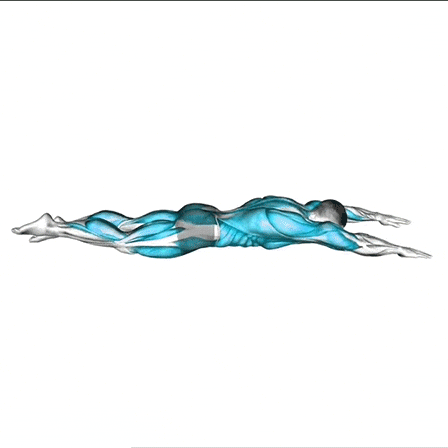Swimming: Total-Body Workout Benefits
Instruction
1. Warm-Up
- Why: Warming up prepares your body for exercise, increases blood flow, and reduces the risk of injury.
- How: Start with light swimming at an easy pace for 5-10 minutes. You can use any stroke, but the front crawl (freestyle) is often ideal as it engages most of your body.
2. Choose the Right Stroke
Each swimming stroke offers different cardiovascular benefits. Consider alternating between strokes for variety:
- Freestyle (Front Crawl): The fastest stroke, great for a high-intensity cardio workout. It works the arms, shoulders, back, and legs.
- Breaststroke: A slower stroke but still effective for a steady pace and long-duration workouts. It's easier on the shoulders and excellent for those new to swimming.
- Backstroke: A good stroke for overall body conditioning with a focus on the back, shoulders, and legs. It’s also helpful for improving posture.
- Butterfly: The most intense stroke, engaging the whole body and providing an excellent cardiovascular workout. It requires good technique and strength.
- Individual Medley (IM): A combination of all four strokes (butterfly, backstroke, breaststroke, and freestyle), which can be a challenging and rewarding way to improve cardiovascular fitness.
3. Build Intensity Gradually
Start with short intervals and gradually increase your distance and speed. Swimming intervals can help maximize cardiovascular benefits. For example:
- Moderate Intensity: Swim continuously for 10-15 minutes at a moderate pace.
- High-Intensity Intervals: Swim for 1-2 minutes at a fast pace, then swim 1-2 minutes at a slow pace or float to recover. Repeat this cycle for 20-30 minutes.
4. Breathing Technique
- Freestyle (Front Crawl): Exhale fully underwater and inhale quickly through your mouth when you turn your head to the side. Practice a rhythm of “exhale, inhale” to keep a steady breathing pattern.
- Breaststroke and Backstroke: These strokes naturally allow you to breathe easier since your face is above water most of the time. Focus on deep, steady breaths.
5. Form and Technique
Proper form maximizes efficiency and minimizes fatigue:
- Freestyle (Front Crawl): Keep your body in a horizontal, streamlined position. Your arms should enter the water fully extended in front, with a slight bend in the elbow. Kick from your hips rather than your knees to maintain a smooth glide.
- Breaststroke: Keep your head and neck relaxed. The arms should sweep in a circular motion, while the legs perform a frog-like kick. Aim for a rhythm of "pull, breathe, kick, glide."
- Backstroke: Keep your body as flat as possible on your back. Keep your arms straight and rotate your body slightly with each stroke.
- Butterfly: This stroke requires good rhythm and timing. Keep your body as flat as possible, and use the "dolphin kick" (both legs moving together) while keeping your arms moving in a windmill motion.
6. Cross-Training
To prevent plateaus and improve overall fitness, mix swimming with other forms of cardio (e.g., running, cycling) or resistance training. This will improve strength and endurance, benefiting your swimming workouts.
7. Cool Down
- Why: Cooling down helps your body gradually return to its resting state, promoting flexibility and muscle recovery.
- How: Swim at an easy pace for 5-10 minutes. Focus on slower, more relaxed strokes and deep breathing.
8. Hydration
- Even though you're in the water, you can still get dehydrated, especially in warm pools. Drink water before, during, and after your swim.
9. Consistency is Key
- Swimming is most effective as a cardio workout when done regularly. Aim for at least 3-4 swim sessions per week to see significant improvements in cardiovascular fitness.
10. Track Progress
- Set goals based on the number of laps or time spent swimming. For example, aim to swim 20 minutes without stopping, or gradually increase your interval intensity as your endurance improves.
Tips
-
Warm-Up:
- Why: Preparing your body for exercise helps prevent injury and increases performance.
- How: Swim at a slower pace for 5-10 minutes using a variety of strokes to gradually elevate your heart rate.
-
Interval Training:
- Why: It improves cardiovascular fitness and burns more calories.
- How: Alternate between periods of high-intensity swimming (e.g., freestyle sprints) and low-intensity (e.g., backstroke or breaststroke).
- Example: Swim 1 lap of freestyle as fast as possible, then 1 lap of breaststroke at a slower pace. Repeat 10 times.
-
Focus on Technique:
- Why: Proper technique reduces fatigue and makes you more efficient in the water.
- How: Work on your breathing, arm strokes, and body position. Keep your body as streamlined as possible to reduce drag.
-
Increase Stroke Count and Intensity:
- Why: To build endurance, gradually increase the number of laps or time spent swimming.
- How: Start with a manageable distance or time, then gradually increase each week. For example, start by swimming 10 minutes, then add 1-2 minutes each session.
-
Stay Consistent:
- Why: Consistency is key for improving cardiovascular fitness.
- How: Aim to swim at least 3-4 times a week for a cardio benefit. Incorporate variety in your workouts to avoid plateaus.
-
Proper Breathing:
- Why: Breathing properly ensures you’re getting enough oxygen, preventing fatigue.
- How: Breathe rhythmically and deeply through your nose when your face is in the water, and exhale through your mouth when your face is out. Practice bilateral breathing for freestyle to maintain balance.
-
Cross-Train:
- Why: To avoid overuse injuries and target muscles that swimming may not fully engage.
- How: Incorporate other cardio activities, like cycling or running, on non-swimming days.











